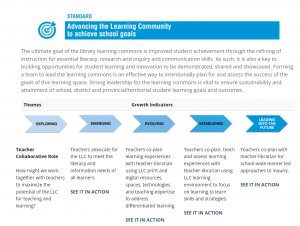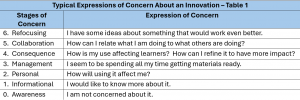This report documents the collaboration and implementation of two non-fiction units for Science and Social Studies with a focus on the effective use of reference resources guided by the Concerns-Based Adoption Model (CBAM). Collaboration took place with Teacher A (gr.2), Teacher B (gr. 2/3), and myself. Both colleagues work in the same school and have vast degrees of teaching experience, education, and exposure to working with reference materials and technology.
The purpose of working with these educators was to evolve their practices in the use of technology and effective use of reference resources. This endeavor espouses the standards of a SLLC in it’s role of Advancing the Learning Community to Achieve School goals as upheld in the CLA’s Leading Learning: Standards of Practice for School Library Learning Commons in Canada (Figure 1) (Canadian School Libraries, 2024).

Figure 1
The CBAM is used to describe, “how people develop as they learn about an innovation and the stages of that process” (Loucks-Horsley, 1996). SoC allows the innovator to address the concerns of the users of the innovation, or program. Addressing the “human side” of change it allows the innovator to support educators right where they are in how they feel and react to something new (American Institutes for Research). Table 1, Typical Expressions of Concern About an Innovation, graphs each stage of concern. Stages are levelled from 0-6 coinciding with a concern state that a teacher may have about a new project.
Levels of Use (LoU) assesses behaviours. Table 2, Levels of Use of the Innovation: Typical Behaviours, graphs the 8 behavioral stages of the user of the innovation (Loucks-Horsley, 1996). This system assesses if the innovation is being used, and at what level.

Table 1

Table 2
Teacher A is a new teacher with two years’ experience. She holds a B.Sc. B.Ed., and a Diploma in Education. She regularly incorporates non-fiction work through many areas of the curriculum. She wanted to embark on a science unit about animals and life cycles. Embedded in the unit was a research component for students to learn about animal habitats. She asked for books on the subject at the Grade 1-2 reading level and for a writing template for students to use. She spent much time gathering materials and templates for students. Her initial method of students reading and searching for key words led to student frustration as many found this task difficult. Using the SoC rating, she is rated at level 3 – Management.
Teacher A asked if we could plan a research unit for her students using quality reference resources. She was very keen to using any reference materials and tools that students would be able to manage and find engaging.
We worked on creating a research experience for her Grade 2 students where they could access reference materials that were engaging and age appropriate. Students conducted research using the digital resource, Live It Earth available through Focused Education Resources. Using I-Pads, students viewed videos about their animal and learned about how it creates its home. Students were more engaged in learning about animal habitats and able to write about what they discovered. This method is supported by Riedling, et al, when they state, “…children have a preference for visual browsing for information over strategic keyword searching, leading to longer, more circuitous searches” (Riedling, Shake, & and Houston, 2013). Teacher A extended their learning by having students re-create an animal habitat with plasticene.
Teacher A evolved from the SoC rating of 3 to 4- Consequence. In reference to the LoU scale, she is rated at 4B – The user is making changes to increase outcomes.
Teacher B is the Grade 2/3 teacher and has been teaching for 21 years. He holds a B.Ed. degree. He does not often use non-fiction texts or digital platforms in his teaching. He is not keen on using technology for research purposes as he believes that younger students will “just watch YouTube videos”. He disclosed that he has not done a research project with many of his young students as he feels their reading levels are low. Using the SoC rating, he is rated at level 0 – I am not concerned about it. Given his level of concern, I offered to work with him on an area of his choice and develop a research unit of inquiry that his students would find engaging.
We developed a research unit using both print, and online materials found in the Canadian Encyclopedia. The theme was “Canadian Notables of Colour” to coincide with Black History month. Students worked with me in the SLLC to formulate a question that would drive their research such as “Who is Viola Desmond and why is she a Trailblazer?” Using non-fiction books and I-Pads to access the digital encyclopedia students researched their notable, learned how to find relevant information and write facts in their words.
Teacher B did not engage with students in the process unless he was asked for assistance. This was limiting for students and myself as work on this project did not happen until it was the class’s scheduled collaboration time (3 times/week). He became more involved as he noticed that his students were engaged in learning and researching. He became interested in what Canadian Encyclopedia had to offer and began perusing the digital classroom on Focused Education Resources for other reference resources. Teacher B transitioned from the SoC rating of 0 to 1. In LoU he rates at level 1.
The Teacher-Librarian role is one that is meant to serve the needs of school community stakeholders. The CBAM is useful for TLs to use in supporting teachers’ development in the use of technology and reference resources to enhance their practice and deepen student learning.
References
American Institutes for Research. (n.d.). Stages of Concern – A Dimension of the Concerns-Based Adoption Model. USA. Retrieved 03 03, 2024, from https://www.air.org/resource/stages-concern-concerns-based-adoption-model
Canadian School Libraries. (2024, March 6). Advancing the Learning Community to Achieve School Goals. Retrieved from Canadian School Libraries : https://llsop.canadianschoollibraries.ca/advancing-learning-community/
Loucks-Horsley, S. (1996). The Concerns-Based Adoption Model (CBAM): A Model for Change in Individuals. Professional Development for Science Education: A Critical and Immedite Challenge. (R. Bybee, Ed.) Dubuque, Iowa: Kendall/Hunt Publishing Co. Retrieved 03 03, 2024, from https://s3.wp.wsu.edu/uploads/sites/731/2015/07/CBAM-explanation.pdf
Riedling, A. M., Shake, L., & and Houston, C. (2013). Reference Skills for the School Librarian: Tools and Tips (3 ed.). Santa Barbara, California: Linworth; ABC-CLIO, LLC.

Linette,
This is so well executed and clear. I realize now that I did not have a clear understanding of this assignment and how to approach it. Oh well, too late now! Live and learn 🙂
I really liked how you dealt with Teacher B in relation to engaging their interest in reference resources available in the library. I find it hard to know how best to approach teacher who are at Level 0. Most people generally don’t respond well to be nagged or lectured on the importance of resource-based learning and engaging students in inquiry. This demonstrates a good way to show it’s benefits to his students, and pique his interest in it so that he is seeking to learn more instead of feeling pressured and overwhelmed.
You have explained the Concerns Based Model very well in your report. I particularly appreciate the additional graphics you have included as a point of reference.